Yes, snake plants are good for oxygen as they produce oxygen even at night. Snake plants are easy to care for, making them an ideal plant for homes and offices.
They can tolerate low light and dry environments, making them perfect for spaces with minimal natural light and air conditioning. Additionally, they are known to remove toxins from the air, including benzene, formaldehyde, and carbon monoxide. Snake plants are also believed to have a calming effect on people, reducing stress and improving mood.
Overall, snake plants are an excellent addition to any space for their health and aesthetic benefits.

Credit: www.healthline.com
Snake Plants: The Oxygen Connection
Snake plants are trendy and make great houseplants. Not only do they add a beautiful touch of greenery to any space, but many also believe they help purify the air and improve the overall atmosphere of a room. One of the most frequently asked questions about snake plants is whether they are good for oxygen.
We’ll delve deeper into this topic and explore the oxygen connection with snake plants. So, let’s get started with exploring how snake plants produce oxygen!
How Snake Plants Produce Oxygen
Snake plants, also known as sansevieria or mother-in-law’s tongue, are known for their excellent air-purifying properties. They do so by actively absorbing harmful pollutants such as benzene, formaldehyde, and nitrogen oxides, which are commonly found in indoor environments. But, how do snake plants produce oxygen?
Snake plants are unique because they belong to the group of plants that produce oxygen even during the night. Unlike most houseplants, which release oxygen during the day through photosynthesis, snake plants use a process called crassulacean acid metabolism (cam).
Cam plants absorb carbon dioxide during the night and store it in their leaves in the form of an organic acid. During the day, they use this stored carbon dioxide to carry out the photosynthesis process and release oxygen into the air.
This means that snake plants not only produce oxygen but also absorb carbon dioxide while other plants cannot.
Explanation Of Photosynthesis In Snake Plants
Photosynthesis is the process of turning light energy into chemical energy. And, snake plants carry out this process during the day. When a snake plant receives light, it absorbs carbon dioxide, water, and sunlight through its leaves. This triggers the process of photosynthesis, in which the plant converts the absorbed components into energy, glucose, and oxygen.
Snake plants then release oxygen back into the air, which makes them ideal for improving air quality in a room.
Comparison Of Oxygen Production In Snake Plants Vs Other Houseplants
While most plants release oxygen during the daytime, snake plants produce oxygen both day and night. This makes them a better option than other popular houseplants in terms of oxygen production. In comparison, here’s how snake plants’ oxygen production stacks up against other commonly found houseplants:
- Snake plants: Produce oxygen both day and night, making them unique and beneficial houseplants to have in the home.
- Aloe vera: Produce oxygen during the day, similar to most plants.
- Peace lily: Produce oxygen during the day and continue to produce a small amount of oxygen during the night.
- Spider plant: Produce oxygen during the day and continue to produce a small amount of oxygen during the night.
If you’re looking for other houseplants that help improve air quality, snake plants are a great option, especially because of their unique capacity to produce oxygen both day and night effortlessly. With this information, choosing snake plants for your home or workspace can only improve the air quality and enhance the beauty of your environment.
Benefits Of Snake Plants For Indoor Air Quality
Are you looking for an easy way to improve the air quality in your home? Snake plants could be just what you need! Not only are they easy to care for, but they’re also great air purifiers. Let’s dive into the benefits of snake plants for indoor air quality.
Explanation Of How Snake Plants Remove Toxins From The Air
Snake plants are also known as “mother-in-law’s tongue,” and they’re one of the best plants for removing toxins from the air. Here’s how they do it:
- Snake plants are able to absorb toxins through their leaves and convert them into oxygen.
- They release moisture into the air, which helps to increase humidity levels in dry indoor environments.
- Snake plants are particularly good at removing formaldehyde, benzene, and trichloroethylene from the air. These are harmful volatile organic compounds (vocs) that can be found in everyday household products like cleaning solutions and paint.
Studies That Demonstrate The Effectiveness Of Snake Plants In Improving Air Quality
Research has shown that snake plants are effective at improving indoor air quality. Here are a few studies that demonstrate their effectiveness:
- A study conducted by nasa found that snake plants were able to remove up to 107 different air pollutants from the air.
- Another study found that snake plants were able to significantly reduce the levels of benzene and formaldehyde in the air.
- A third study found that snake plants were able to absorb up to 53% of vocs in indoor air after just 24 hours.
Comparison Of Snake Plants To Other Air Purifying Houseplants
While there are many plants that purify the air, snake plants are particularly effective. Here’s how they compare to other popular air-purifying houseplants:
- Snake plants are more effective at removing benzene than any other plant.
- They’re also more effective at removing formaldehyde than most other plants.
- Compared to other plants, snake plants release oxygen at night, making them a great choice for bedrooms.
If you’re looking for an easy and effective way to improve the air quality in your home, snake plants are a great option. They’re easy to care for, great at removing toxins from the air, and look great in any room.
Plus, with so many different varieties available, you’re sure to find one that suits your style.
Snake Plants For Enhancing Sleep
Have you been struggling to get a good night’s sleep? Have you tried everything from changing your mattress to adjusting your sleeping schedule but still haven’t found relief? It’s time to try a snake plant!
Explanation Of How Snake Plants Improve Sleep Quality
Snake plants, also known as sansevieria, are great indoor plants for improving the quality of your sleep. They have unique qualities that make them stand out from other plants. Here’s how snake plants help with sleep:
- Releases oxygen into the air that improves the room’s air quality.
- Converts carbon dioxide into oxygen at night, helping you breathe better.
- Releases moisture into the air, maintaining a proper humidity level that prevents dry throat and snoring.
- Reduces stress and anxiety by creating a calming environment.
Explanation Of How Snake Plants Remove Carbon Dioxide From The Air, Promoting Better Sleep
When we sleep, our body takes in oxygen and releases carbon dioxide. If there is too much carbon dioxide in the air, it can make us feel restless and uncomfortable, leading to poor sleep quality. Snake plants are one of the few plants that are known for their ability to remove carbon dioxide from the air.
Snake plants absorb carbon dioxide through small pores in their leaves, and release oxygen back into the air. In addition, they continue to absorb carbon dioxide even at night, making them perfect plants for keeping in your bedroom.
Studies That Demonstrate The Effectiveness Of Snake Plants In Improving Sleep Quality
Numerous studies have shown that snake plants have a positive effect on sleep quality. Here are a few examples:
- A study conducted by nasa found that snake plants, among other indoor plants, can remove harmful pollutants from the air, improving air quality and therefore, sleep quality.
- A study published in the journal of physiological anthropology found that snake plants can reduce stress and anxiety levels and promote a feeling of calm in individuals, leading to better sleep quality.
- A study conducted by the university of agriculture in faisalabad, pakistan, found that snake plants can absorb carbon dioxide and release oxygen even at night, making them ideal plants to keep in your bedroom for better sleep quality.
If you’re looking to improve the quality of your sleep, consider keeping a snake plant in your bedroom. With their ability to release oxygen and reduce carbon dioxide levels, they’re sure to help you get a good night’s sleep.
Snake Plants: Low Maintenance, High Reward
Snake plants have been touted as one of the best indoor plants to have for a myriad of reasons, and this article seeks to explore one of them: their ability to produce oxygen. However, before we delve into that, let’s discuss one of the most significant benefits of this plant – it requires low maintenance but yields high rewards.
The snake plant is a great option for those who want the beauty of houseplants without the hassle and high maintenance that comes with them. Here are some of the reasons why:
- Snake plants can thrive in low light conditions, making it a great option for people who lack a lot of natural light in their homes.
- Watering requirements for snake plants are relatively minimal, as they only need to be watered every 2-3 weeks.
- Snake plants are very resilient and can tolerate neglect for extended periods.
All of these factors make snake plants a perfect choice for people with busy schedules who don’t have the time to devote to caring for finicky houseplants.
Comparison Of Snake Plants’ Cost And Maintenance To Other Houseplants
Another important factor to consider when choosing houseplants is the cost and maintenance required. Snake plants are an excellent investment, as they are relatively inexpensive and require low maintenance.
Here is a brief comparison of the cost and maintenance of snake plants vs. other popular houseplants:
- Snake plants vs. pothos: Both snake plants and pothos are low-maintenance plants, but snake plants tend to require less water and can tolerate lower light conditions. Additionally, snake plants produce oxygen at night, while pothos do not.
- Snake plants vs. fiddle leaf fig trees: Fiddle leaf fig trees are incredibly trendy and chic, but they are also high maintenance and require a lot of attention. Snake plants, on the other hand, are much easier to care for and are much more affordable.
- Snake plants vs. spider plants: Spider plants are a great option for low-maintenance houseplants and are relatively affordable, but they don’t produce oxygen like snake plants do. Additionally, spider plants require more frequent watering than snake plants.
Tips For Caring For Snake Plants
To ensure that your snake plant thrives, here are some essential care tips to keep in mind:
- Be mindful of watering: Overwatering can be deadly to a snake plant, so be sure to let the soil dry out in between waterings.
- A little bit of light goes a long way: While snake plants can tolerate low light, they still need some light to survive. Place your snake plant in a bright, indirect light to encourage healthy growth.
- Don’t worry about repotting too often: Snake plants thrive in small pots and don’t need to be repotted often.
- Keep an eye out for pests: Spider mites and mealybugs can be an issue with snake plants, so be sure to keep an eye out for any signs of infestation. If you notice any, treat the plant promptly to avoid any damage.
Snake plants are a great option for people who want beautiful indoor plants without the hassle of high maintenance or cost. They produce oxygen at night, require low watering, and can tolerate low light. With the tips outlined above, you can ensure that your snake plant thrives for years to come.
Frequently Asked Questions For Are Snake Plants Good For Oxygen
Are Snake Plants Good For Oxygen?
Yes, snake plants are known to be good for oxygen production. They have the ability to convert carbon dioxide into oxygen.
How Do Snake Plants Improve Air Quality?
Snake plants absorb toxins from the air, such as formaldehyde, benzene, and xylene, which improves air quality.
Can Snake Plants Be Toxic To Pets?
Yes, snake plants are mildly toxic to pets such as cats and dogs. The plant contains saponins which can cause gastrointestinal upset.
How Often Should I Water My Snake Plant?
Snake plants require very little water and can go several weeks without being watered. Water only when the soil is completely dry.
Do Snake Plants Need A Lot Of Sunlight?
Snake plants can tolerate a wide range of lighting conditions, but they prefer indirect sunlight. Direct sunlight can cause the leaves to burn.
Conclusion
As indoor air pollution is a growing concern, having plants like snake plants can improve the air quality in your home. These hardy plants not only add a beautiful touch to your decor, but they also remove harmful pollutants and release oxygen back into the air.
Snake plants’ unique ability to absorb co2 during the night and convert it into oxygen makes them stand out from other houseplants. By reducing toxins and increasing oxygen levels, these plants can improve your overall health and well-being. Plus, they are easy to care for and require minimal maintenance.
Including snake plants in your home decor can help you breathe easier and lead a healthier life. So, if you are looking for an efficient and effective way to purify the air in your home, snake plants are a great choice!



